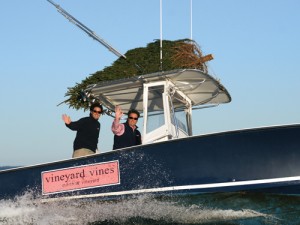 In Part One of this column, we took a look at the philosophy and strategy behind the brand that is Vineyard Vines. Now, let’s look at the business side of that ubiquitous pink whale.
In Part One of this column, we took a look at the philosophy and strategy behind the brand that is Vineyard Vines. Now, let’s look at the business side of that ubiquitous pink whale.
A very important thing to note about Vineyard Vines is that they are opening brink-and-mortar stores while almost any other brand in this market segment is either closing them of postponing any further retail expansion (let alone refurbishment of existing units).
Vineyard Vines’ decision to follow a corporate/institutional branding strategy alongside its retail market is a big reason for their resiliency in the current economic environment. Their corporate/college/sporting division’s business offsets, or at least makes less impactful the capital costs of their retail operation.
This duel market strategy and Shep and Ian’s ability to create a real and passionate culture around their brand are two key reason that they are thriving while other bigger and better financed brands are just trying to stay afloat.
 Early on, the company focused on the college market as a key demographic and it has been a successful effort. Go into any college store anywhere in the country and you are likely to find Vineyard vines branded ties, polos and tote bags. That well-known repeated logo pattern is a virtual signature telling you from a distance that the Dartmouth green necktie with the never-ending shield repeat is the work of Shep and Ian.
Early on, the company focused on the college market as a key demographic and it has been a successful effort. Go into any college store anywhere in the country and you are likely to find Vineyard vines branded ties, polos and tote bags. That well-known repeated logo pattern is a virtual signature telling you from a distance that the Dartmouth green necktie with the never-ending shield repeat is the work of Shep and Ian.
Hitting The Books
In the same spirit of Jimmy Buffet, Vineyard Vines has college tours that bring the brand’s lifestyle directly to college students on their campuses. Complete with beach parties and pink foam whale hats reminiscent of Buffet’s “land sharks” they are marketing the Vineyard Vines brand directly to a core consumer audience. Some critics point out that in some segments – namely fraternal groups – the brand has become synonymous with boozy college keg parties. While not really the company’s fault, it’s a persistent form of collateral brand damage none the less.
Unflattering subsets aside, this kind of legwork does indeed develop an enthusiastic and educated customer base predisposed to support the brand and product outside of the college environment. They see their support of the brand as integral to their own lifestyle. Tell me of any retail lifestyle brand that wouldn’t want a market full of grade school-to-country club ambassadors.
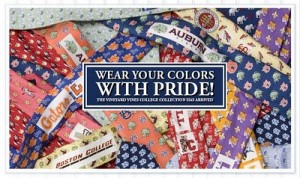 How is all this managed? The company has a business unit dedicated to producing customized designs for colleges, their sport teams and fraternal organizations.
How is all this managed? The company has a business unit dedicated to producing customized designs for colleges, their sport teams and fraternal organizations.
Think of it as a collegiate marketing version of vertical integration. If it works right, pretty much anything that campus needs will run through, or at least by, their Vineyard Vines rep. To keep these collegiate efforts coordinated and effective, Vineyard Vines has dedicated brand managers who focus solely on the university market; working with student leaders, administrators and sports teams.
A key goal of course is that as these students grow up and head off to their own careers, a new supply of Vineyard Vines diehards are ready to open their wallets. They’ll graduate to corporate casual, weekend and country club lives and bring Vineyard Vines along for the ride. The thing that makes this philosophy tangible is that unlike other aspirational brands – the ones that let you believe that buy wearing their shirt or shoes you too will live in a countryside estate – the Vineyard Vines “lifestyle” is approachable and believable.
The Vineyard Vines world is populated by people you know doing things to which we can all relate: having weddings and graduations, going to parties and just hanging out with friends. That life is not only easy to aspire to, it’s tangible and easily made real though you and your best friends all sporting the same Vineyard Vines tie and khakis in that Christmas party picture. Now that’s aspirational branding.
Wearing the Whale
The brand also fits nicely into the preppy/New England Americana trend that has been evolving for the past few years. In fact, rather than losing steam the look seems to be gaining, moving into new markets and creating its own subsets of “authentic” work wear, classically inspired sportswear and deeper dives into the prep school ethos.
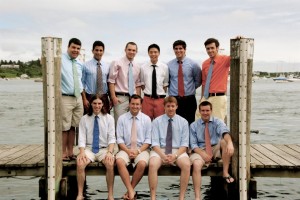 The brand also has an appeal that reaches those who will never set foot on the Vineyard and who will never be part of “that” life and the continuing economic downturn provides a silver lining of sorts because customers are drawn to safe, stable, familiar styles now more than ever.
The brand also has an appeal that reaches those who will never set foot on the Vineyard and who will never be part of “that” life and the continuing economic downturn provides a silver lining of sorts because customers are drawn to safe, stable, familiar styles now more than ever.
The company’s classic, some say pedestrian, designs will be in style for years and have a certain malleable nature that engages both New England Gold Casters and Southern preps used to bolder color palates. Typically, Vineyard Vines pieces are not standouts; rather they are good compliments of other aspects of an outfit. Supporting, rather than starring roles as it were.
Fall 2010 changed up this historical rule however and it seems that Vineyard Vines’ designers were looking to the highly stylized designs of Ralph Lauren’s Rugby brand for some inspiration. Mild compared to Rugby’s hyper prep school look, but still a noticeable uptick on the style front.
 For some then, the traditional designs of Vineyard Vines shirts, pants and shorts represent stylistic security as well as comfort. As an OTC reader one observed, Vineyard Vines is no Ralph Lauren. While the two share a seaside/preppy/windswept lifestyle brand, Ralph is champagne and oysters, Shep and Ian are Sam Adams and lobster rolls.
For some then, the traditional designs of Vineyard Vines shirts, pants and shorts represent stylistic security as well as comfort. As an OTC reader one observed, Vineyard Vines is no Ralph Lauren. While the two share a seaside/preppy/windswept lifestyle brand, Ralph is champagne and oysters, Shep and Ian are Sam Adams and lobster rolls.
The brand has never been about highbrow, but it does appeal to the lifestyle sensibilities of many who want some of the privileged coastal life. Functionality plays role as well. A Vineyard Vines polo, tie, fleece jacket or classic “bare feet” D-ring belt will be in style now, a year from now and probably 10 years from now.
Their tote bags have become, especially for many young women, signature accessories. Other items like blazers, oxfords, shorts and pants all reinforce the Vineyard Vines lifestyle without the overbearing brand association of a Ralph Lauren-like status issue. The message is often that if you are a Vineyard Vines person, you are a fun loving low key brand ambassador who doesn’t need go out of your way to impress others.
Washington, D.C., has also found the brand to be a good fit. Apart from its appealing natural heritage and traditional preppy theme, there is a long running and bipartisan relationship that politicians, particularly from the Northeast, have with Vineyard Vines ties.
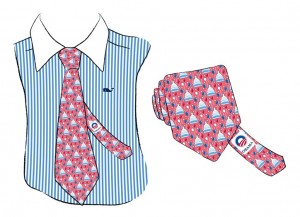 During his 2004 presidential run, Senator John Kerry (D-MA) commissioned blue donkey ties for his staff which quickly attained must-have status. Since then, Vineyard Vines ties and belts sporting donkeys, elephants, and American flags regularly dress up blue or red political operatives from Capitol Hill to K Street.
During his 2004 presidential run, Senator John Kerry (D-MA) commissioned blue donkey ties for his staff which quickly attained must-have status. Since then, Vineyard Vines ties and belts sporting donkeys, elephants, and American flags regularly dress up blue or red political operatives from Capitol Hill to K Street.
For then-Senator Obama’s 2008 presidential run, Vineyard Vines came up with Capitol Domes and the Obama “O” logo on the tail. Is there a now a White House version? Hmmm, I’ll have to check on that.
Even those classic Vineyard Vines totes have been tricked out with blue/donkey or red/elephant trim – my direct observation showing this item to be a perpetual de rigeur accessory for Hill interns and staff alike.
The Business of Fun
From a purely business perspective, Shep and Ian are pretty smart guys. They understand the power of branding and customer association to the Vineyard Vines island lifestyle. They are heavily involved in non-profit, good will and social activities in many of their key markets. The brothers understand the financial and marketing benefits of letting their brand grow organically and in markets that make sense.
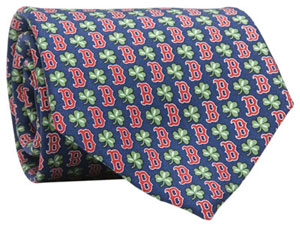 One of those markets is corporate branding. The company produces neckties and select garments and accessories for the National Football League and Major League Baseball. Where one might typically expect to see repeating sailboats, instead team logos scroll across ties.
One of those markets is corporate branding. The company produces neckties and select garments and accessories for the National Football League and Major League Baseball. Where one might typically expect to see repeating sailboats, instead team logos scroll across ties.
In announcing the NFL deal several years ago, SportsBusiness Daily, quoted NFL Vice President of Consumer Products Susan Rothman saying, “we have ties in the market, but they don’t have the quality that Vineyard Vines has.” She went on to say that additional team branded Vineyard Vines products are a logical next step.
In addition to its collegiate and professional sports business ventures, Vineyard Vines provides an extensive corporate branding service that captures lucrative company contracts for employee polos, fleece, etc., and corporate gifts, like tote bags, hats and jackets.
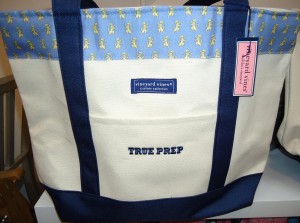 Cashing on on the blog-fueled interest in TRUE PREP, the long-awaited follow-up to The Original Preppy Handbook, the company partnered with author Lisa Birnbach to play host to a national book signing tour and produced a capsule collection of TRUE PREP branded product. the move garnered attention from multiple quarters and also positioned, or re-positioned if you will, Vineyard Vines as a classic brand equal to L.L. Bean when it comes to its preppy DNA.
Cashing on on the blog-fueled interest in TRUE PREP, the long-awaited follow-up to The Original Preppy Handbook, the company partnered with author Lisa Birnbach to play host to a national book signing tour and produced a capsule collection of TRUE PREP branded product. the move garnered attention from multiple quarters and also positioned, or re-positioned if you will, Vineyard Vines as a classic brand equal to L.L. Bean when it comes to its preppy DNA.
Minding The Store
Vineyard Vines has taken a creative approach to its retail outlets as well. The company makes a concerted effort not to cannibalize existing retailers whenever possible. In many cases, they actually partner with their existing retailers in developing a new stand-alone Vineyard Vines store.
This strategy captures local market knowledge and existing customer bases, engenders goodwill with their local partners and consolidates retail channels. It also frees up the corporate team to focus on product development and branding efforts.
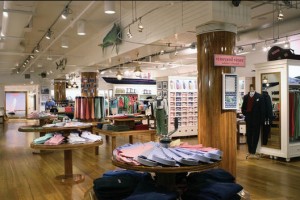 The company has won numerous awards, including being named a 2008 All-Star Awards winner by Apparel Magazine for outstanding achievements in the apparel industry. Though it certainly has its detractors, Vineyard Vines continues to be a case study in creating and building a passionate and successful business.
The company has won numerous awards, including being named a 2008 All-Star Awards winner by Apparel Magazine for outstanding achievements in the apparel industry. Though it certainly has its detractors, Vineyard Vines continues to be a case study in creating and building a passionate and successful business.
The company also invests in robust back office and supply chain management software. Controlling costs and inventory across the various retail platforms (web, catalog, company store and retail) is just as vital as customer development.
Vineyard Vines’ website is regularly refreshed, while still retaining it’s clean and brand-appropriate friendly feel. Though relatively new, the company’s blog, “The Vine” is refreshingly non-corporate feeling. An active Twitter feed and Facebook fan page round out a robust if relaxed social media platform.
If there is an area of legitimate concern regarding Vineyard Vines’ brand, I think it is the issue of brand dilution. By moving into so many tangential markets – collegiate, fraternal, club, professional sports, corporate – the Murrays do run the risk of muddling what Vineyard Vines really means. If I can pick up a dozen San Francisco 49ers Vineyard Vines ties at Marshall’s for $12.99, exactly how special is that brand? What lifestyle am I really buying?
It’s a legitimate concern and frankly one I suspect has already been mulled over up at the Stamford, Connecticut, headquarters.

Rather than drooling over Vineyard Vines, wouldn’t it be better to simply acknowledge that the company has effectively cornered the market in preppy-dufus “style”?
I was a groomsman in three weddings in the middle of the last decade. Instead of opting for the rented black-tie monkey suits, my New Englander friends all opted for khaki or cream-colored pants, a blue blazer of our choosing and Vineyard Vines ties to match the dresses of the bridesmaids.
I thought it was a nice touch at the time and am reminded of these couples and the great time we all had at their weddings every time I tie one of them around my neck.
We all have to make a living, of course. But having read this post, one has to ask the following: are you in the pay of “Ian and Shep”?
To the trash with this article.